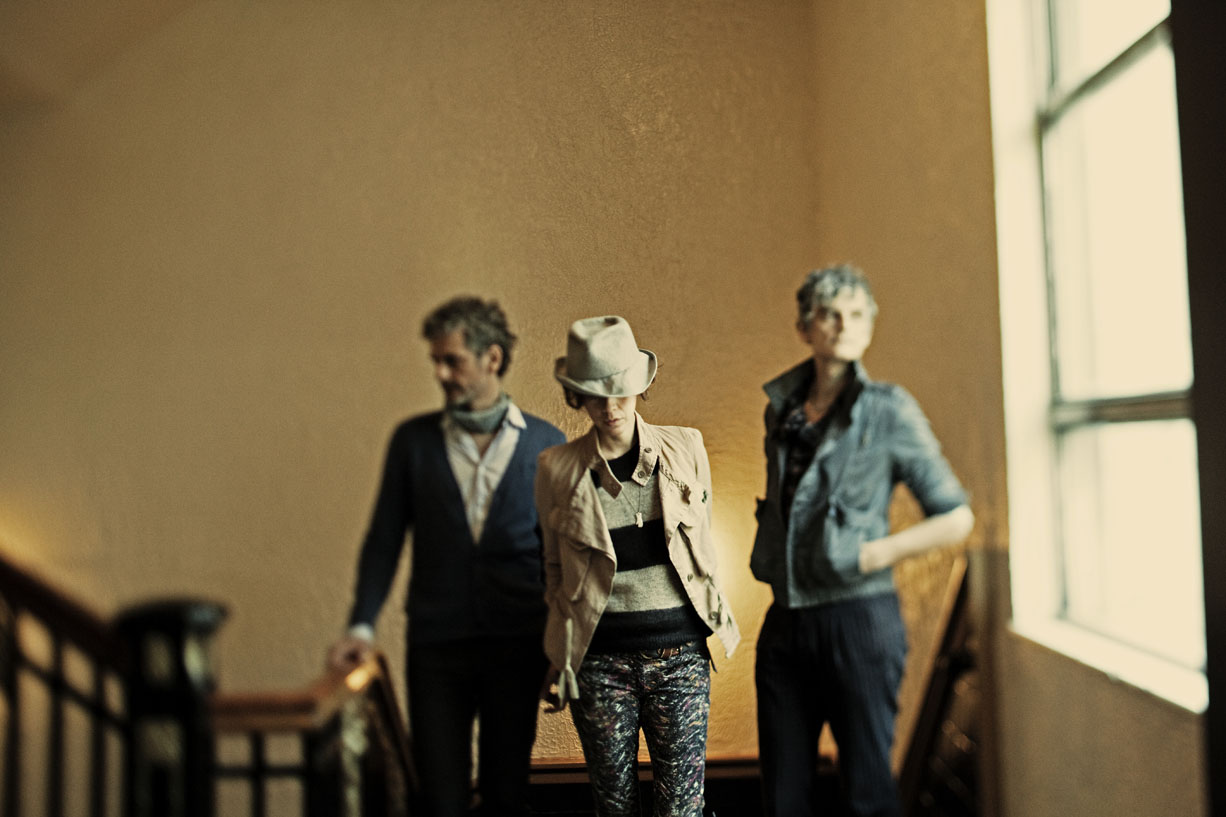 Blonde Redhead: Penny Sparkle (4AD, 9/14/10)
Blonde Redhead: Penny Sparkle (4AD, 9/14/10)
Blonde Redhead: “Here Sometimes”
[audio:https://alarm-magazine.com/wp-content/uploads/2010/12/heresometimes.mp3|titles=Blonde Redhead: “Here Sometimes”]Having just returned from Australia and “sleeping the days away” while jet lag slowly lifts, Kazu Makino is particularly soft spoken over the telephone. Back at home, the guitarist/vocalist for New York’s esteemed experimental indie outfit Blonde Redhead sounds a bit subdued, until her French Papillon puppy interrupts from the background and she has to excuse herself.
“I used to think they were the ugliest dogs,” she says later in the conversation. As Makino was looking for a small dog that she could bring on extended tours, friends started suggesting the Papillion breed, identified by their big ears and powerful lungs, the kind of dog that Makino was shy about being seen with, calling to mind images of the dogs slung over shoulders in over-sized purses. But that distaste soon turned into fascination, fascination turned to love, and before long, Makino was a complete convert. And, funny enough, she relates the same way to her music.
Forming Blonde Redhead nearly 20 years ago in New York City with Italian-born twin brothers Amedeo and Simone Pace, the Japanese-born Makino has been creating and experiencing music in an ever-new and exciting light. “It doesn’t feel like that long,” she says of Blonde Redhead’s span. “Time passes unknowingly. I’m always searching, discovering new music, always amazed by people. I think, how do they know this about music? How do they know what to do?”
“Maybe there’s only so many places or ideas in you. There might be a moment when I realize it’s over. If it’s unlimited, I want to keep going — see how much there is.”
Beginning as a no-wave-inspired band in the vein of early supporters Sonic Youth, featuring Makino and Amedeo on guitars and Simone playing drums, the trio has, over the years, turned into another identity all together, hardly recognizable from its origins and often marked by increasingly imaginary dream pop. Blonde Redhead, as a band, continually and dramatically progresses, reacting against previous sounds or moods and exploring the more uncomfortable aspects of music. “I am always outside of my comfort zone,” Makino jokes. “I don’t even have a comfort zone!”
That feeling was never more pronounced than in the months of writing and recording Blonde Redhead’s last album, Penny Sparkle. “We wanted a minimal-sounding record, stripped down,” she says. Diving into a world of electronic music, Makino and the Pace brothers began looking to Europe and eventually worked with Swedish electronic producers Van Rivers and The Subliminal Kid (Henrik Von Sivers and Peder Mannerfelt) in a more collaborative process than the group had ever previously experienced.
Moving away from the full, dreamy pop of its 2007 LP, 23, the group pared the guitars to bare arpeggios, and instead propelled its songs with synthesized textures, sharply exacting beats, and Makino’s effervescent voice floating entrancingly overhead. “Some moments were extremely uncomfortable, even in choosing sounds or arrangements,” Makino says. “But, still, we wanted to try it. For that reason, we wanted to try it. Even if we felt like it wasn’t really us.” Looking back, these were the most compelling, most fulfilling moments for the band.
“You go through so many twists and turns; there’s no way to explain exactly how it ends up on record, no way to trace back,” Makino says. With Amedeo making the transition from guitar to keys and Makino separately singing in studios halfway across the globe, the band felt more than a little displaced after the labored process of recording. Then, once the dramatically different sound started playing out, it took many fans and critics by surprise, and some had difficulty explaining Blonde Redhead’s latest departure. The initial mixed reactions over such an already tenuous and often disputed ordeal of an album were distressing.
Soon, however, those questions were put firmly to rest. After playing its new minimalist material around the world and experiencing the positive reaction to its intense wall-of-sound live show, the band’s reward is a deeper understanding of the new songs and a deeper appreciation for the music. “It’s always fresh,” Makino says. “Playing it loud, playing it live, it’s a whole different thing. We take full advantage creating that space. The new songs come out more raw live. They make a lot more sense.”
It is exactly this constant sense of gratifying discovery, following the initial fear and unease, that has kept Blonde Redhead moving forward for so long. It simply never gets old for Makino and the Pace brothers. “I don’t know know what else I’d do,” Makino says. “Whenever it feels uncomfortable, it also feels new, fresh. It’s always compelling.” Walking the fine line of intuitive and forced perspective, the trio of artists never just blindly moves along its path of discovery — that much is clear. Yet it’s hard for Makino to exactly explain some of the motivations and pressures that drive the group forward.
“There is a fear of repeating,” she says. “You know, maybe I’m just repeating myself over and over, but people are too polite to say anything. But it feels new.” Speaking from her own vantage point, Makino experiences these moments of inspiration like water lifted from a well, unseen in the darkness until after the strain of pulling up buckets from the void. “Maybe there’s only so many places or ideas in you,” she continues. “There might be a moment when I realize it’s over. If it’s unlimited, I want to keep going — see how much there is.”
Blonde Redhead creates and innovates so well precisely because its three artists constantly challenge themselves and each other. Speaking of brothers Amedeo and Simone, Makino adoringly chides, “Sometimes, I can’t stand the twins! They can be difficult people. But I love the songs we write together. As soon as we play music, we are so close; I don’t feel like anything is wrong, and I like that.
“I’m very slow, like a turtle,” she adds. “They are hyper. If they were animals, they’d be squirrels. When we get together, my day is just beginning, but they’ve been up for hours; their day may even be ending. They urge me to get up and play. It really helps.” As Makino speaks of the twins and the band’s uniquely intimate relationship, the love and admiration in her voice shines through. That constant sense of wonderment and awe that she described earlier when speaking of the musical community in general goes double for the twins.
Makino admits that it’s hard to be totally objective about Penny Sparkle, in the same way that it is impossible to be objective about a new puppy. However, her initial feelings of discomfort and self-doubt have made stronger the bond that she now shares with the new music and her new companion. And while the group now prepares for a massive spring cleaning of sorts, it’s clear that Makino and Blonde Redhead have so much yet to do, to explore, and to challenge themselves with.


